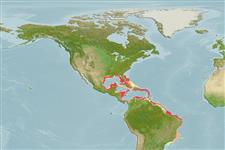>
Eupercaria/misc (Various families in series Eupercaria) >
Labridae (Wrasses) > Corinae
Etymology: Halichoeres: Greek, als, alis = salt + Greek, choiros = pig (Ref. 45335).
More on author: Bloch.
Environment: milieu / climate zone / depth range / distribution range
Ecologie
marien rifbewoner; diepte 18 - 91 m (Ref. 7251), usually 30 - ? m (Ref. 52607). Tropical; 30°N - 33°S, 98°W - 32°W
Western Atlantic: Florida, USA and Antilles to Brazil.
Grootte / Gewicht / Leeftijd
Maturity: Lm ? range ? - ? cm
Max length : 30.0 cm TL mannelijk / geslacht onbekend; (Ref. 7251)
Dorsale stekels (totaal) : 9; Dorsale zachte stralen (totaal) : 12; Anale stekels: 3; Anale zachte stralen: 12. Juveniles and females yellow with broad blue stripe from eye to center of caudal fin. The only Halichoeres species in Caribbean region with 12 dorsal rays, all other have 11 (Ref. 26938). Adults with a broad black stripe on upper half of body; narrowing as it passes posteriorly to end in middle of caudal fin; lower half of body light blue-green; head below level of mouth blue-green, above yellow (Ref. 13442).
Found over hard substrates (Ref. 9626). Juveniles up to 8 cm act as specialized cleaners. Each individual tends a defined cleaning station sought by several species of reef fishes including damselfishes, goatfishes, and surgeonfishes. At the cleaning station this wrasse swims in a characteristic seesaw motion (Ref. 31373). Occasionally caught by anglers. Generally of no interest to fisheries because of its small average size (Ref. 5217). Found at 9 m in Belize (Ref. 26938).
Levenscyclus en paargedrag
Maturities | Voortplanting | Spawnings | Egg(s) | Fecundities | Larven
Distinct pairing during breeding (Ref. 205).
Robins, C.R. and G.C. Ray, 1986. A field guide to Atlantic coast fishes of North America. Houghton Mifflin Company, Boston, U.S.A. 354 p. (Ref. 7251)
Status op de Rode Lijst van het IUCN (Ref. 130435)
Gevaar voor de mens
Harmless
Gebruik door de mens
Visserij: commercieel; sportvis: ja; Aquarium: Commercieel
Tools
Speciale rapporten
Download XML
Internetbronnen
Estimates based on models
Preferred temperature (Ref.
123201): 21.1 - 27.6, mean 25.4 °C (based on 91 cells).
Fylogenetische diversiteitsindex (Ref.
82804): PD
50 = 0.5000 [Uniqueness, from 0.5 = low to 2.0 = high].
Bayesian length-weight: a=0.00955 (0.00451 - 0.02020), b=3.09 (2.92 - 3.26), in cm total length, based on LWR estimates for this Genus-body shape (Ref.
93245).
Trofisch niveau (Ref.
69278): 3.6 ±0.54 se; based on food items.
Weerstandsvermogen (Ref.
120179): Gemiddeld, minimale populatieverdubbelingstijd 1,4-4,4 jaar (Preliminary K or Fecundity.).
Fishing Vulnerability (Ref.
59153): Low vulnerability (20 of 100).
Nutrients (Ref.
124155): Calcium = 52.1 [30.7, 86.4] mg/100g; Iron = 0.669 [0.392, 1.226] mg/100g; Protein = 18.3 [15.5, 20.5] %; Omega3 = 0.153 [0.097, 0.239] g/100g; Selenium = 32 [18, 57] μg/100g; VitaminA = 173 [57, 594] μg/100g; Zinc = 1.27 [0.88, 1.93] mg/100g (wet weight);
